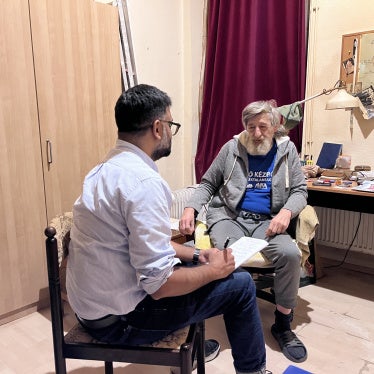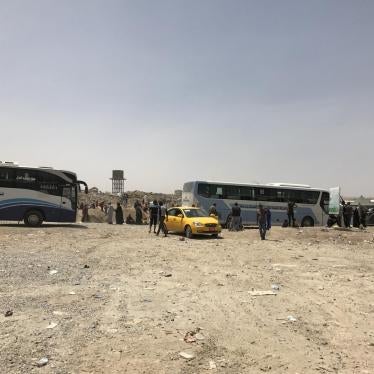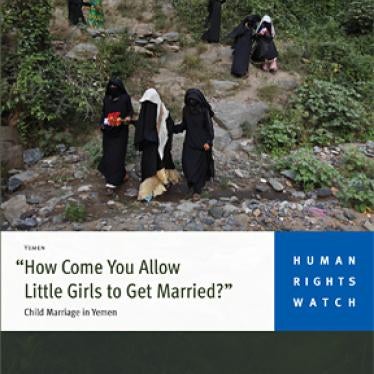Human Rights Watch would like to express our appreciation to the Special Rapporteur (SR) on the right of everyone to the enjoyment of the highest attainable standard of physical and mental health for the opportunity to provide this submission, which responds to the SR’s call for input regarding the situation of health and care workers and their ability to enjoy and support the realization of the right to health and related human rights.[1]
Human Rights Watch is an independent, international non-governmental organization that investigates and reports on rights violations in over 100 countries worldwide. Human Rights Watch documents human rights abuses and directs advocacy toward governments, armed groups, and businesses, pressing them to change or enforce their laws, policies, and practices to ensure that all human rights are respected, protected, and fulfilled.
For years, Human Rights Watch has investigated structural barriers to the availability, acceptability, accessibility, and quality of health care around the world. Below, we have drawn from some of our recent research to provide summary responses to several “Key Questions” raised in the SR’s call for input, which we hope will help inform the SR’s next thematic report to the Human Rights Council.
Key Questions
- “Please share examples of reprisals and acts committed against health and care workers related to their work defending the right to health and related rights (e.g. attacks, targeting of health and care workers, their families, colleagues, or institutions, detention, other means of pressure).”
Gaza: Unlawful Israeli Attacks on Medical Facilities, Personnel, and Transport
Israeli forces have arbitrarily detained at least 310 healthcare workers in Gaza since hostilities began in October 2023, according to the Gaza Ministry of Health.[2] The detention of healthcare workers in the context of the Israeli military’s repeated attacks on hospitals in Gaza has contributed to the catastrophic degradation of the besieged territory’s healthcare system.[3]
Human Rights Watch interviewed eight Palestinian healthcare workers who were taken by the Israeli military from Gaza between November and December 2023 and detained without charge or trial for between seven days and five months.[4] Six were detained at work following Israeli sieges of hospitals or during hospital evacuations that they said had been coordinated with the Israeli military.
Released Palestinian doctors, nurses and paramedics described humiliation, medical neglect, deprivation of adequate food and water, and physical abuse and beatings, including being punched, kicked with steel-toed boots, slapped, and beaten with assault-rifle butts by Israeli soldiers.[5] They also reported torture, including rape and sexual abuse, forced stress positions, and near-constant cuffing and blindfolding by Israeli forces.[6]
- One paramedic said that at the Sde Teiman detention facility he was suspended from a chain attached to handcuffs, electroshocked, denied medical care for broken ribs caused by beatings, and administered what he believed was a psychoactive drug before interrogations.[7]
- Khader Abu Nada, 30, a nurse at Beit Hanoun hospital in northern Gaza, said that when he denied any Hamas affiliation during his first interrogation at a military base in Gaza, the commander threatened to rape him with an “electric stick.” When Abu Nada continued to deny any affiliation, soldiers beat him until he was bleeding from his nose, hands, and mouth. Abu Nada said the commander then asked him where his mother was and threatened to bring her from the checkpoint where he was arrested and strip her in front of everyone.[8]
- A nurse detained at Anatot said, “We got two meals [a day]. It was terrible food. I would just drink water, there were no fruits, not even apples. They gave us food just to survive the day.”[9]
Ethiopia: Attacks on Medical Care in Ethiopia’s Amhara Conflict
Ethiopian security forces have carried out widespread attacks against health care amounting to war crimes in the context of armed conflicts in the country.[10] In the Amhara region, Ethiopian soldiers killed, beat, detained, and threatened medical professionals and staff, accusing them of treating or providing care to opposing forces and further hampering access to health care.[11]
- In South Wollo Zone, an apparent strike on an ambulance transporting three healthcare workers, killed two health workers, badly wounded one, and destroyed much-needed medical supplies in November 2023.[12]
- In January 2024, Ethiopian soldiers detained and interrogated a medical professional for several days in a military camp after demanding to see medical records and accusing him of providing care to wounded fighters.[13]
- In September 2023, government soldiers slapped and threatened a hospital administrator at gunpoint after he refused to turn over medications to the military.[14]
- A doctor working in a West Gojjam Zone hospital said that government soldiers beat the hospital’s medical director after he returned with critical medications and other supplies in early January 2024. Soldiers also regularly humiliated or threatened staff, including slapping health workers and forcing them to remove rocks blocking the road.[15]
During the 2020-2022 armed conflict in the Tigray region, Ethiopian soldiers and allied forces, including Eritrean soldiers and Amhara fighters, also attacked and intimidated Tigrayan aid providers and health workers providing health and medical care to survivors of sexual violence.[16]
- In March 2021, Ethiopian federal police raped two medical students at Ayder hospital. According to a health worker who spoke with the students: “One [assailant] said, ‘You look Tigrayan, we are allowed to rape you.’”[17]
- Soldiers also entered health facilities searching for specific rape survivors or health records. In March 2021, government forces carried out a three-day raid on a safehouse run by the Women’s Association of Tigray in Mekelle, the only such functioning shelter for rape survivors for many months of the conflict. A representative told Human Rights Watch: “The soldiers came in and searched for documents and looked through the documents…. While they were there, they locked the 37 survivors in the living room. And they are once again retraumatized, some even peed themselves.” Police subsequently detained one staff member for several hours at the police station.[18]
- “Are there laws and policies in your country that impact the ability of health and care workers to provide accessible, affordable, acceptable, quality health care services (e.g. in contexts such as abortions, drug use, infectious diseases and pandemics including COVID-19, health needs of particular groups including women, LGBTIQ+, transgender and gender-diverse persons, migrants and refugees, persons living in rural areas, sex workers, inter alia)? If so, how do these laws and policies impact the ability of health and care workers to support the realisation of the right to health for these populations?”
United States: Bans on Gender-Affirming Care
Over twenty states in the United States have enacted legislative bans on gender-affirming medical care for transgender youth, leaving over 36 percent of such youth in the country without access to this health care.[19]
This dramatic shift marks a departure from pre-2021 policies when no US states restricted such care. These bans position the United States alongside a handful of nations — including Russia and Iraq —in enacting blunt restrictions on transgender healthcare, defying international medical and human rights standards.[20]
The bans contradict best practice in medical care. Major US medical associations uniformly advocate for access to meticulously tailored, developmentally appropriate care for transgender youth.[21] These bans prohibit these treatments only when used for gender dysphoria; cisgender youth maintain access to puberty blockers and hormone therapies for other medical conditions.[22]
Gender-affirming care bans severely restrict healthcare providers' ability to deliver evidence-based care. Healthcare providers found in violation of these bans risk having their medical licenses revoked and may face other, often costly, legal and civil penalties.[23]
Six states classify providing gender-affirming care as a felony offense, while nine states have vague "aiding and abetting" clauses that may restrict providers from even basic healthcare functions like offering referrals, managing medical records, discussing out-of-state treatment options, refilling prescriptions, or running lab tests.[24] The ambiguous wording of these laws has led to widespread "overcompliance," where providers restrict more care than legally required due to fear of prosecution.[25]
These bans have forced many clinics to stop offering gender-affirming care, while others endure violent harassment, including bomb threats, death threats, and online doxxing.[26] Providers in states without bans also face litigation threats from out-of-state officials, creating a chilling effect nationwide.[27]The resulting climate forces providers to adopt expensive security measures or relocate their practices, further straining access to care.
Beyond transgender youth, these bans create systemic strain on healthcare delivery. States with bans already faced provider shortages, particularly in specialties like adolescent medicine and pediatric endocrinology, and medical institutions report declining residency applications.[28] Providers in unrestricted states now face overwhelming caseloads,reducing access for all patients.[29] This compounding crisis undermines healthcare in underserved areas, demonstrating how targeting gender-affirming care erodes broader systems of care, harming both transgender individuals and the general population.[30]
United States: State-Based Abortion Bans and Laws to Prosecute Medical Personnel for Providing Abortion Services to Residents Who Travel Out of State
In fourteen US states, abortion is banned; another four states have restricted access to abortion services to as early as six weeks of pregnancy; and three states have restrictions from twelve or eighteen weeks.[31] In states with full bans there are one or several exceptions to the bans, which are either to “prevent the death” or “preserve the life” of the pregnant individual or to allow abortion in cases where the pregnancy is a result of rape or incest.[32] However, these exceptions are often vague, and the decision as to whether or not they apply is not made by the physician providing care to the patient.
Physicians who perform abortions or assist in abortion-related care face severe legal consequences in states where abortion is banned. They could face jail time, lose their medical license or get sued. In Texas, doctors who are considered to have provided an illegal abortion could face up to 99 years in prison.[33] This has become a major issue for emergency room doctors, who often get visits from pregnant people who require health care services for miscarriage management that could be interpreted as assisting them with an abortion.[34]
These policies have resulted in dangerous delays of care and several pregnant people have died in states with bans, as emergency room staff feared repercussions of providing necessary medical treatment. ProPublica, a US-based investigative journalism nonprofit, has documented five cases of pregnant women in the US dying after receiving inadequate care or being denied a legal abortion as of November 2024.[35] In recent months, three Texas women died under such circumstances, one of whom was denied care at three separate emergency rooms as the staff feared repercussions.[36]f
- “Are there economic policies or other factors that negatively impact your country’s health system (including access to medicines, vaccines, and other health products), and consequently undermine the ability of health and care workers to provide available, acceptable, accessible, and quality healthcare services?”
Global Failures of Healthcare Financing
Analysis of global health expenditure data from 2000-2021 shows that, despite a surge in healthcare spending in response to the Covid-19 pandemic, many governments’ policy and budgeting decisions have resulted in healthcare financing models that factor in states’ failure to ensure universal access to quality healthcare goods and services.[37]
Drawing on the most recent available data published by the World Health Organization (WHO), HRW recently found a moderate-to-strong, positive correlation (+0.64; n=187) between public healthcare spending as a percent of GDP and coverage for essential healthcare services as measured by the WHO’s UHC Service Coverage Index.[38] But in 2021, despite the pandemic-related surge in healthcare spending, 38 governments spent less on health care, as a share of their GDP, than they did the year before the pandemic began.[39]
HRW also found that when governments don’t fund health care, either through tax-generated funds or contributory social health insurance programs, individuals and households are left to shoulder the burden.[40] Overall, in 2021, individuals and households in 47 countries collectively paid more out-of-pocket for health care than their governments spent on it.[41]
For many governments, the lack of adequate public funding of health care is part of a longer trend. When adjusted for inflation into 2021 values, 16 governments spent less on health care per person in 2021 than they did in 2000.[42]
While public healthcare spending does not necessarily capture all of governments’ efforts to realize the right to health, it is a strong indicator of governments’ priorities. To better align those priorities with the realization of human rights, we recommend that governments:
- Set a goal to spend through domestically-generated public funds the equivalent of at least 5 percent of GDP or 15 percent of general government expenditures on health care, or an amount that otherwise ensures the dedication of the maximum available resources for the realization of rights, including the right to health;
- Avoid reductions in funding for health care, unless under exceptional circumstances publicly justified, as outlined by the UN Committee on Economic, Social and Cultural Rights; and
- Increase available public resources to allocate to public health care through progressive taxes and changes to policy and enforcement to reduce tax abuses.
International Monetary Fund (IMF): Austerity Loan Conditions Risk Undermining Rights
An increase in debt servicing costs has constrained many governments’ spending, including on health.[43] High debt burdens have also led many governments to request loans from the International Monetary Fund, which often imposes lending conditionalities that can further undermine government spending on health.[44] Although in the early stages of the pandemic the IMF and other lenders were critical in helping governments scale up their spending on health, IMF programs expected many of these governments to sharply scale down spending within a short timeframe.[45]
A Human Rights Watch analysis of 39 loan programs approved in the three years following the start of the Covid-19 pandemic in March 2020 found that the vast majority included austerity measures and that the social spending floors, intended in part to mitigate the harmful impacts of these measures, were flawed and ineffective.[46]
Creditor governments and the lending institutions they fund and govern, like the IMF, should assess the impact of debt payments on the ability of governments to meet their human rights obligations and consider debt restructuring or relief where appropriate to ensure governments can adequately respect, protect, and fulfil all human rights, including the right to health.[47]
Conclusion
Human Rights Watch would like to thank the SR again for the opportunity to provide input on the situation of health and care workers. We would be happy to provide any additional information, and also welcome the opportunity to further discuss these cases and our recommendations.
Sincerely,
A. Kayum Ahmed Program Lead, Global Health Initiative Human Rights Watch | Matt McConnell Researcher, Global Health Initiative Human Rights Watch | Caitlin Williams
Coordinator, Global Health Initiative |
[1] Office of the High Commissioner for Human Rights, Special Rapporteur on the Right to Health, “Call for input: health and care workers as key protectors of the right to health,” https://www.ohchr.org/en/calls-for-input/2025/call-input-health-and-care-workers-key-protectors-right-health.
[2] Israel: Palestinian Healthcare Workers Tortured,” Human Rights Watch, August 26, 2024, https://www.hrw.org/news/2024/08/26/israel-palestinian-healthcare-workers-tortured.
[3] Ibid. See also “Gaza: Unlawful Israeli Hospital Strikes Worsen Health Crisis,” Human Rights Watch, November 14, 2023, https://www.hrw.org/news/2023/11/14/gaza-unlawful-israeli-hospital-strikes-worsen-health-crisis (“The Israeli military’s repeated, apparently unlawful attacks on medical facilities, personnel, and transport are further destroying Gaza’s healthcare system and should be investigated as war crimes…. The World Health Organization (WHO) has reported that at least 521 people, including 16 medical workers, have been killed in 137 “attacks on health care” in Gaza as of November 12. These attacks, alongside Israel’s decisions to cut off electricity and water and block humanitarian aid to Gaza, have severely impeded health care access. The United Nations found as of November 10 that two-thirds of primary care facilities and half of all hospitals in Gaza are not functioning at a time when medical personnel are dealing with unprecedented numbers of severely injured patients. Hospitals have run out of medicine and basic equipment, and doctors told Human Rights Watch that they were forced to operate without anesthesia and to use vinegar as an antiseptic.”).
[4] Israel: Palestinian Healthcare Workers Tortured,” Human Rights Watch, August 26, 2024, https://www.hrw.org/news/2024/08/26/israel-palestinian-healthcare-workers-tortured.
[5] Ibid.
[6] Ibid.
[7] “A Palestinian Paramedic’s Ordeal in Israeli Detention,” Human Rights Watch, August 26, 2024, https://www.hrw.org/news/2024/08/26/palestinian-paramedics-ordeal-israeli-detention.
[8] “Israel: Palestinian Healthcare Workers Tortured,” Human Rights Watch, August 26, 2024, https://www.hrw.org/news/2024/08/26/israel-palestinian-healthcare-workers-tortured.
[9] Ibid.
[10] “’If the Soldier Dies, It’s on You:’ Attacks on Medical Care in Ethiopia’s Amhara Conflict,” Human Rights Watch, July 3, 2024, https://www.hrw.org/report/2024/07/03/if-soldier-dies-its-you/attacks-medical-care-ethiopias-amhara-conflict. See also “Ethiopia: Army Attacks Health Care in Amhara Conflict,” Human Rights Watch, July 3, 2024, https://www.hrw.org/news/2024/07/03/ethiopia-army-attacks-health-care-amhara-conflict.
[11] Ibid.
[12] Ibid.
[13] Ibid.
[14] Ibid.
[15] Ibid.
[16] “’I Always Remember That Day:’ Access to Services for Survivors of Gender-Based Violence in Ethiopia’s Tigray Region,” Human Rights Watch, November 9, 2021, https://www.hrw.org/report/2021/11/09/i-always-remember-day/access-services-survivors-gender-based-violence-ethiopias.
[17] Ibid.
[18] Ibid.
[19] Gender-affirming care encompasses a spectrum of practices, from changes in appearance (haircut, wardrobe change) to mental health counseling to medical treatments such as puberty blockers and hormone therapies, all emphasizing a personalized, multidisciplinary, and considerate approach. For more information, please see, Association of American Medical Colleges, "What Is Gender-Affirming Care? Your Questions Answered," https://www.aamc.org/news/what-gender-affirming-care-your-questions-answered. See also Movement Advancement Project, "Equality Maps: Bans on Best Practice Medical Care for Transgender Youth." https://www.mapresearch.org/equality-maps/healthcare/youth_medical_care_bans; Williams Institute, "How Many Adults and Youth Identify as Transgender in the United States?" June 2022, https://williamsinstitute.law.ucla.edu/publications/trans-adults-united-states.
[20] See Associated Press, "Russian President Signs Legislation Marking the Final Step Outlawing Gender-Affirming Procedures," July 24, 2023, https://apnews.com/article/russia-lgbtq-transgender-procedures-banned-21b88f53b9a74a646400d63ce93bde6f (accessed December 10, 2024); “Iraq: Repeal Anti-LGBT Law,” Human Rights Watch news release, May 20, 2024, https://www.hrw.org/news/2024/05/20/iraq-repeal-anti-lgbt-law; WPATH, Standards Of Care For Health Of Transgender And Gender Diverse People, version 8 (2022), https://www.tandfonline.com/doi/full/10.1080/26895269.2022.2100644; GATE (2023) Reaffirming Autonomy of Trans and Gender Diverse Children and Adolescents. New York: GATE, https://www.arcusfoundation.org/wp-content/uploads/2024/02/Reaffirming-Autonomy-of-TGD-Children-and-Adolescents.pdf.
[21] The American Medical Association (AMA), the American academy of Pediatrics (APA), American Psychological Association, and American Academy of Child and Adolescent Psychiatry, have all released statements and guidelines in support of gender-affirming care for youth, please see: “AMA to states: Stop interfering in health care of transgender children,” American Medical Association press release, Chicago, April 26, 2021, https://www.ama-assn.org/press-center/press-releases/ama-states-stop-interfering-health-care-transgender-children; “AAP reaffirms gender-affirming care policy, authorizes systematic review of evidence to guide update,” American Academy of Pediatrics policy statement, August 4, 2023, https://publications.aap.org/aapnews/news/25340/AAP-reaffirms-gender-affirming-care-policy?autologincheck=redirected; “APA Policy Statement on Affirming Evidence-Based Inclusive Care for Transgender, Gender Diverse, and Nonbinary Individuals, Addressing Misinformation, and the Role of Psychological Practice and Science,” American Psychological Association, February 2024, https://www.apa.org/about/policy/transgender-nonbinary-inclusive-care; AACAP Statement Responding to Efforts to ban Evidence-Based Care for Transgender and Gender Diverse Youth,” American Academy of Child and Adolescent Psychiatry, November 8, 2019, https://www.aacap.org/AACAP/Latest_News/AACAP_Statement_Responding_to_Efforts-to_ban_Evidence-Based_Care_for_Transgender_and_Gender_Diverse.aspx.
[22] Gender dysphoria refers to a clinically significant distress from the discordance between one’s sex assigned at birth and one’s gender identity. For example, please see: Center for Health Law and Policy Innovation, "Protecting Trans Health Care: Battling Gender-Affirming Care Bans in the Courts," August 1, 2024, https://chlpi.org/wp-content/uploads/2024/07/Health-Care-In-Motion-Gender-Affirming-Care-Bans_7.30.24.pdf (“Under SB1 [Tennessee’s legislation banning gender-affirming care], a child assigned female at birth who identifies as a girl (i.e., a cisgender girl) could be prescribed puberty-delaying medication to treat precocious puberty; but a child assigned male at birth who identifies as a girl (i.e., a transgender girl) could not be prescribed puberty-delaying medication to treat gender dysphoria. Similarly, a cisgender boy could be prescribed testosterone to correct a hormone imbalance; but a transgender boy could not be prescribed testosterone to treat gender dysphoria. In both examples, under SB1, two otherwise identical adolescents could be granted or denied medically necessary care on the basis of their assigned sex at birth.”).
[23] For example, in October 2024, Texas filed a lawsuit against Dallas-based doctor May Lau, accusing her of violating the state's gender-affirming care ban. The case is among the first of its kind in the nation, with Paxton seeking $10,000 in penalties per violation, amounting to potential liability of hundreds of thousands of dollars and Dr. Lau’s medical license being vulnerable to revocation. Yasemin Smallens, “Texas Targets Doctor Over Gender-Affirming Care Ban,” commentary, Human Rights Watch, October 21, 2024, https://www.hrw.org/news/2024/10/21/texas-targets-doctor-over-gender-affirming-care-ban.
[24] The six states that classify providing such care as a felony offense are Alabama, Florida, Idaho, Oklahoma, North Dakota, South Carolina. Movement Advancement Project, "Equality Maps: Bans on Best Practice Medical Care for Transgender Youth." The nine states that have “aiding and abetting” clauses are Arkansas, Florida, Iowa, Indiana, Mississippi, Montana, Ohio, South Carolina, Utah. For more information, please see: KFF, "Policy Tracker: Youth Access to Gender Affirming Care and State Policy Restrictions," November 26, 2024, https://www.kff.org/other/dashboard/gender-affirming-care-policy-tracker/.
[25] Adam Polaski, “As Laws that Restrict Gender-Affirming Care Take Effect Across the South, Overcompliance Leads to Compounding Harms for Transgender Youth and their Families,” Campaign for Southern Equality, November 9, 2023, https://southernequality.org/overcompliance/.
[26] See Online Harassment, Offline Violence,” Human Rights Campaign report, December 8, 2022, http://hrc.im/OnlineHateReport.
[27] For example, in November 2023, Texas’s Attorney General, Ken Paxton, subpoenaed Seattle Children’s Hospital for records on Texas children receiving such care, but the hospital is legally contesting the demand as an unconstitutional effort to restrict out-of-state care. William Melhado, “Seattle Children’s Hospital sues Texas Attorney General over trans patient records,” The Texas Tribune, December 21, 2024, https://www.texastribune.org/2023/12/21/texas-attorney-general-trans-seattle-childrens/.
[28] Data shows that states with bans have only one-third the number of adolescent medicine providers compared to states without bans: McNamara M, Sequeira GM, Hughes L, Goepferd AK, Kidd K, “Bans on Gender-Affirming Healthcare: The Adolescent Medicine Provider's Dilemma,” J Adolesc Health 73(3) (2023):406-409. doi: 10.1016/j.jadohealth.2023.05.029. See also Shefali Luthra, "‘We’re Not Going to Win That Fight’: Bans on Abortion and Gender-Affirming Care Are Driving Doctors from Texas," The 19th, June 21, 2023, https://19thnews.org/2023/06/abortion-gender-affirming-care-bans-doctors-leaving-texas/.
[29] Associated Press, "States That Protect Transgender Health Care Now Try to Absorb Demand," August 15, 2023, https://www.chicagotribune.com/2023/08/15/states-that-protect-transgender-health-care-now-try-to-absorb-demand/.
[30] For example, in October 2024, Texas Attorney General Ken Paxton sued a pediatric endocrinologist serving the larger El Palso community who had a history of treating children with various endocrinological conditions, most notably, many with type 1 diabetes. Due to the ban and subsequent litigation, this doctor, one of few pediatric endocrinologists in area, may no longer be able to provide care for children needing endocrinological care: Eleanor Klibanoff, "Second Texas Doctor Sued for Providing Gender-Affirming Care to Minors," The Texas Tribune, October 30, 2024, https://www.texastribune.org/2024/10/30/paxton-sues-El-Paso-doctor-transgender/.
[31] Allison McCann and Amy Schoenfeld Walker, “Tracking Abortion Bans Across the Country,” New York Times, December 3, 2024, https://www.nytimes.com/interactive/2024/us/abortion-laws-roe-v-wade.html.
[32] See Mabel Felix, Laurie Sobel and Alina Salganicoff, “A Review of Exceptions in State Abortion Bans: Implications for the Provision of Abortion Services,” Kaiser Family Foundation, June 6, 2024, https://www.kff.org/womens-health-policy/issue-brief/a-review-of-exceptions-in-state-abortions-bans-implications-for-the-provision-of-abortion-services/.
[33] Stacy Weiner, “Emergency doctors grapple with abortion bans,” Association of American Medical Colleges, October 22, 2024, https://www.aamc.org/news/emergency-doctors-grapple-abortion-bans.
[34] Ibid.
[35] Lizzie Presser and Kavitha Surana, “A Third Woman Died Under Texas’ Abortion Ban. Doctors Are Avoiding D&Cs and Reaching for Riskier Miscarriage Treatments,” ProPublica, November 25, 2024, https://www.propublica.org/article/porsha-ngumezi-miscarriage-death-texas-abortion-ban.
[36]Brittany Fonteno, “Another Texas Woman Died Because of Abortion Ban: Nevaeh Crain,” National Abortion Federation, November 1, 2024, https://prochoice.org/another-texas-woman-died-because-of-abortion-ban-nevaeh-crain/.
[37] “Global Failures on Healthcare Funding Pandemic Data Reveals Threats, Opportunities to Improve Systems,” Human Rights Watch, April 11, 2024, https://www.hrw.org/news/2024/04/11/global-failures-healthcare-funding.
[38] Ibid. See also “UHC Service Coverage Index (SDG 3.8.1),” World Health Organization, https://www.who.int/data/gho/data/indicators/indicator-details/GHO/uhc-index-of-service-coverage.
[39] Ibid.
[40] Ibid. In 2021, there was a moderate, negative correlation between public healthcare spending as a share of GDP and the share of healthcare costs paid by individuals and households out of pocket, with this relationship strongest among low-income countries (-0.63; n=25).
[41] Ibid.
[42] Ibid.
[43] Ibid. See also “Bandage on a Bullet Wound IMF Social Spending Floors and the Covid-19 Pandemic,” Human Rights Watch, September 25, 2023, https://www.hrw.org/report/2023/09/25/bandage-bullet-wound/imf-social-spending-floors-and-covid-19-pandemic; “IMF: Austerity Loan Conditions Risk Undermining Rights Compound Problems of Rising Inequality, Flawed Mitigation Efforts,” Human Rights Watch, September 25, 2023, https://www.hrw.org/news/2023/09/25/imf-austerity-loan-conditions-risk-undermining-rights.
[44] “Bandage on a Bullet Wound IMF Social Spending Floors and the Covid-19 Pandemic,” Human Rights Watch, September 25, 2023, https://www.hrw.org/report/2023/09/25/bandage-bullet-wound/imf-social-spending-floors-and-covid-19-pandemic.
[45] Ibid.
[46] Ibid.
[47] Ibid. See also “Global Failures on Healthcare Funding Pandemic Data Reveals Threats, Opportunities to Improve Systems,” Human Rights Watch, April 11, 2024, https://www.hrw.org/news/2024/04/11/global-failures-healthcare-funding.








